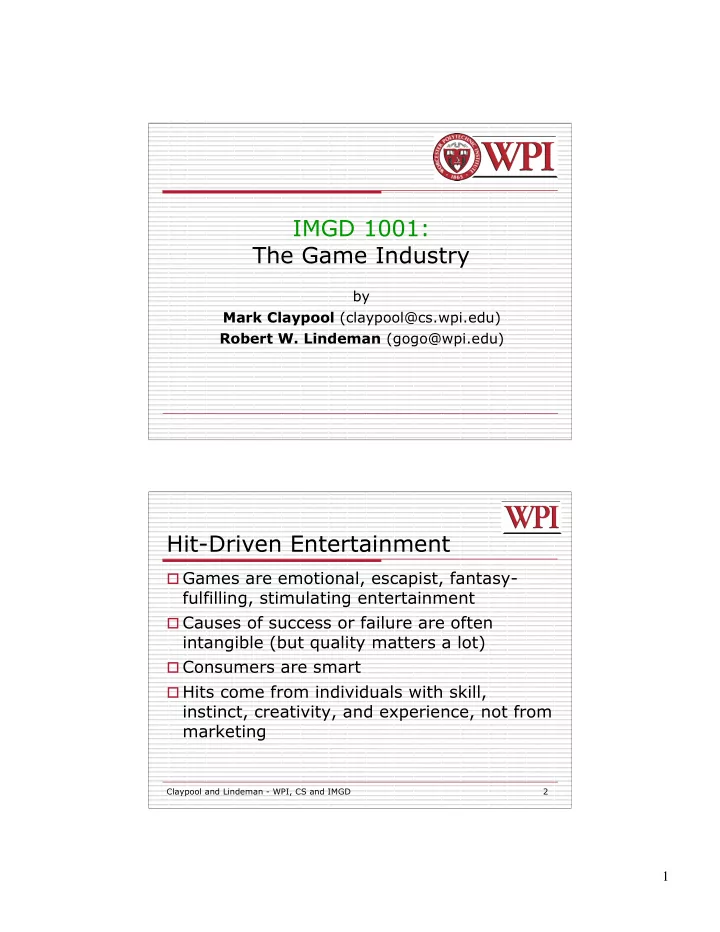

IMGD 1001: The Game Industry by Mark Claypool (claypool@cs.wpi.edu) Robert W. Lindeman (gogo@wpi.edu) Hit-Driven Entertainment Games are emotional, escapist, fantasy- fulfilling, stimulating entertainment Causes of success or failure are often intangible (but quality matters a lot) Consumers are smart Hits come from individuals with skill, instinct, creativity, and experience, not from marketing Claypool and Lindeman - WPI, CS and IMGD 2 1
Costs Powers of 10 $50K - cell phone game (JAMDAT bowling) $500K - indie title (MindRover), nice casual game (Peggles) $5M - “A” title (Titan Quest) $50M - “AAA” ti tle (WoW) Claypool and Lindeman - WPI, CS and IMGD 3 World of Warcraft $50 Million to make 6 Million players @ average of about $12 / month for 2-3 months = $200 million a year (Less the cost of running those servers) Claypool and Lindeman - WPI, CS and IMGD 4 2
How the game industry works: Claypool and Lindeman - WPI, CS and IMGD 5 Roles Developer Publisher Distributor Retailer Toolmaker Service Provider Claypool and Lindeman - WPI, CS and IMGD 6 3
Developers Design and implement games Responsible for the content Including: programming, art, sound effects, and music Historically, small groups but often larger Analogous to book authors Sometimes first party (part of publisher) Or third party (independent business) (More later -- most of this class!) Claypool and Lindeman - WPI, CS and IMGD 7 Publishers “To find the publisher in any deal, look for the one who’s got negative cash-flow during development” Dan Scherlis Handle manufacturing, marketing, PR, distribution, support Typically specialized in certain markets Assume the risk, reap the profits Might also handle QA, Licensing, project management Claypool and Lindeman - WPI, CS and IMGD 8 4
Publishers relationship to developers Star developers can bully publishers, because publishers desperate for good content Most developers are bullied by publishers, because developers are desperate for money Publishing swings from big to small and back depending on the market Most also have in-house developers Claypool and Lindeman - WPI, CS and IMGD 9 Distributors Move software from publisher to retailer Modeled on book distribution Pubs like them because they manage relationship with many small stores Stores like them because they manage relationship with many pubs Compete on price, speed, availability Very low margins (3%) -- dying breed Claypool and Lindeman - WPI, CS and IMGD 10 5
Retailers Sell software to end users But really sell shelf space to publishers Compete on price, volume of product Shift in 80’s to game specialty stores, especially chains (Today 25%) EB Games , GameStop Shift in 90’s to mass market retailers (Today 70%) Target , WalMart , Best Buy Retailers earn 30% margin on a $50 game Electronic download of games via Internet still in infancy Big but not huge (Today 5%) Claypool and Lindeman - WPI, CS and IMGD 11 Service Providers Sound, Music, Voiceover Artists (2D, 3D, concept) QA PR Advertising Claypool and Lindeman - WPI, CS and IMGD 12 6
Middleware Provide the tools used by developers Small: Game Maker, Torque Medium: Havok, Rad Game Tools Large: Doom, Unreal Engine Few customers, large upfront cost, hard to break in...limited growth but profitable Claypool and Lindeman - WPI, CS and IMGD 13 Traditional Game Development Developer creates concept Developer builds demo Developer meets with publishers Publisher agrees to fund it (advance against royalty) Project gets developed Publisher boxes it, ships it, markets it Publisher collects money Developer MIGHT make more money...if advance is earned out Claypool and Lindeman - WPI, CS and IMGD 14 7
Traditional Model: Cross Between Books and Hollywood Less than 10% of published titles break even Sequels very popular Development costs rising Self-publishing is nearly suicidal Retail and distribution control access to customers Claypool and Lindeman - WPI, CS and IMGD 15 Indie Game Development Developer creates concept Developer turns concept into a game Developer finds nontraditional publisher to sell game Sometimes self-publishes Publisher responsible for Web storefront Developer gets 30-40% of each sale Claypool and Lindeman - WPI, CS and IMGD 16 8
Exercise: Getting to Market 2 minutes to write a one-sentence game description of a game you want to make Form up into pairs or teams based on yesterday’s pairings 2 minutes to decide on ONE of your ideas Claypool and Lindeman - WPI, CS and IMGD 17 Exercise: Allocate Points You have 14 points Allocate 0-6 points for each of the following facets: P: Prototype/Pitch How much effort you place on developing a solid prototype to pitch to publishers D: Development How much effort you place on development M: Marketing/Sales How much effort you place on marketing your project F: Fun How effective your design is in terms of how much consumers like your product Claypool and Lindeman - WPI, CS and IMGD 18 9
Exercise: Roll the Dice! Everyone stand up For each roll of the die, please sit down if the number is greater than the points you allocated for that facet P: Prototype/Pitch D: Development M: Marketing/Sales F: Fun Claypool and Lindeman - WPI, CS and IMGD 19 Exercise: How Many are Left? Yes, luck is a factor You can control it some with skill and money But there’s never enough of either to make it a sure thing Claypool and Lindeman - WPI, CS and IMGD 20 10
Recommend
More recommend